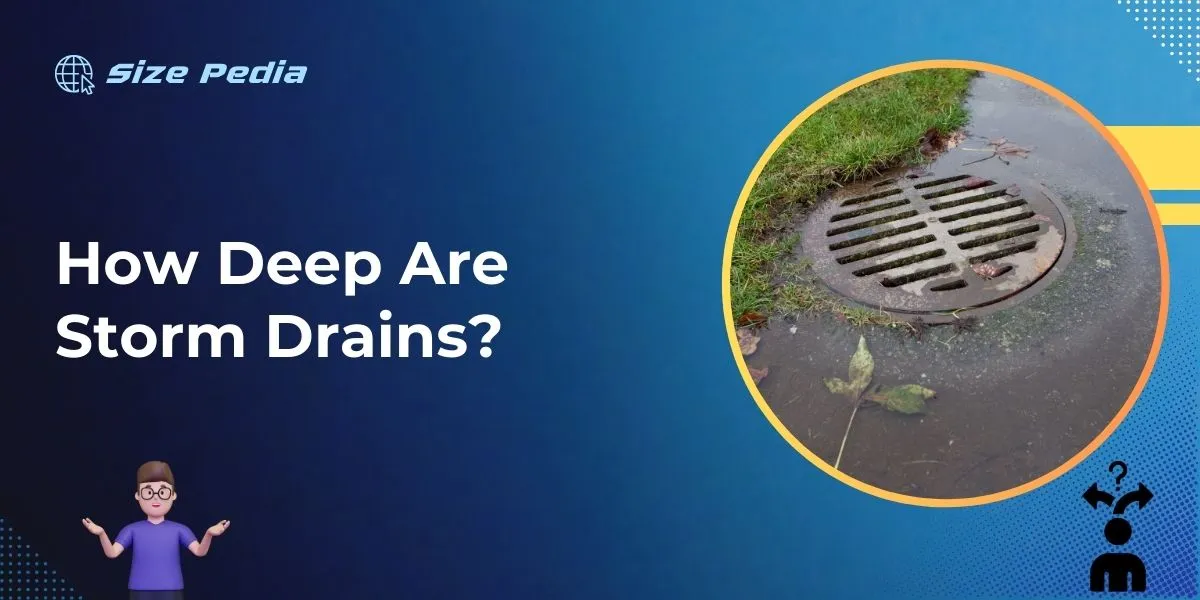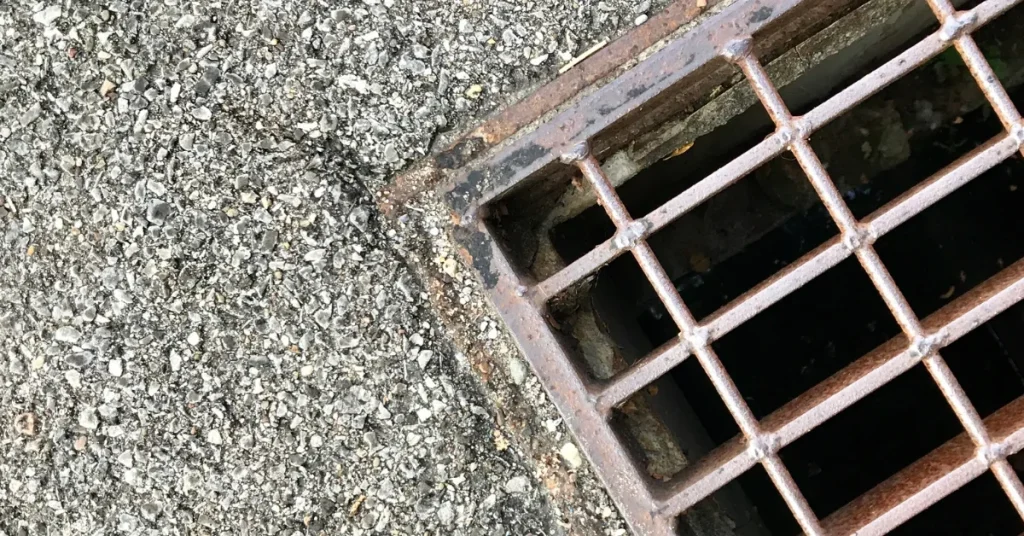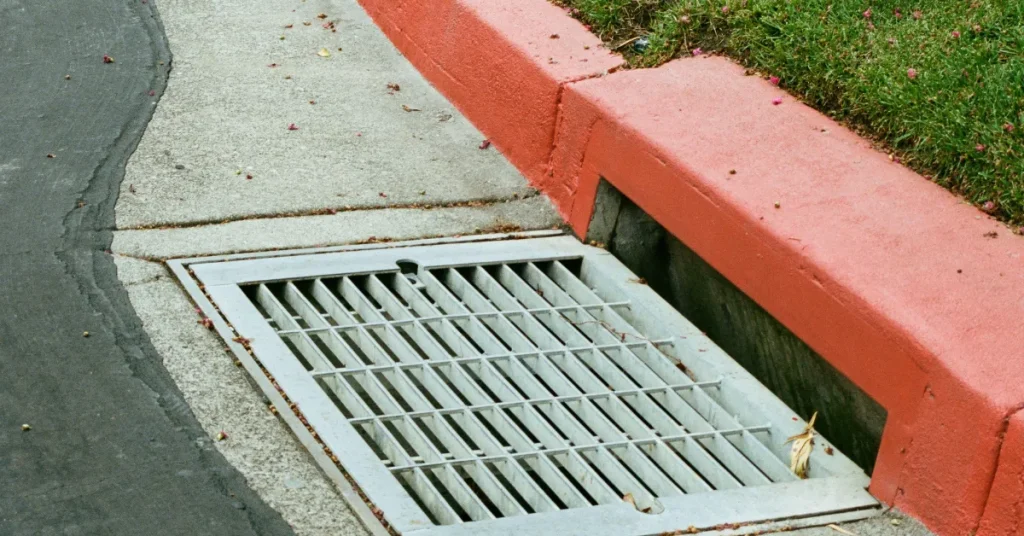Storm drains vary in depth; they are typically around 3 to 10 feet deep. The actual depth can vary based on the system design and local requirements.
Storm drains play a crucial role in urban infrastructure, channeling rainwater and street runoff away from city streets to prevent flooding. These underground pipes are essential for managing water flow in both residential and metropolitan areas.
Engineers and city planners consider several factors when determining the depth of storm drains, including the volume of water to be managed, soil conditions, and the presence of other utilities.
That ensures the system can handle local rainfall patterns without interfering with other services.
Properly designed storm drains reduce the risk of water damage to roadways and nearby properties, contributing to a safer and more efficient environment for the community.

Plunging Into The Depths: Storm Drain Dimensions
Understanding the size and depth of storm drains is key to appreciating their role in urban water management. Let’s dive into what goes on beneath our cities.
City-specific Variations
Storm drain dimensions can vary widely depending on the location. Factors such as rainfall patterns and city planning play a crucial role. Some cities may have shallow drains, while others go much deeper.
| City | Average Depth |
| New York | 12-15 feet |
| Los Angeles | 6-8 feet |
| Seattle | 8-10 feet |
These numbers can help residents and city officials make informed decisions about storm drain maintenance and safety.
Design Factors That Influence Depth
The depth of storm drains isn’t random. Designers consider multiple factors to decide how deep the drains should be.
- Regional climate: Heavier rainfall requires deeper drains to prevent flooding.
- Soil type: Some soils absorb water quickly, while others don’t, affecting the needed depth.
- Infrastructure: The presence of basements, subways, and foundations can impact drain depth.
Each factor ensures the storm drain system functions effectively, no matter the conditions above or below ground.
Blueprints Below: The Architecture Of Urban Drainage
Peering into the world of urban infrastructure reveals a complex network known as storm drains. These sprawling subterranean systems, often overlooked, play a crucial role in modern cities.
Beneath the bustling streets, storm drains ensure efficient water management and flood prevention.
Standard Structures Of Storm Drains
Storm drains come in various shapes and sizes. Yet, a common blueprint persists. Typical storm drain designs consist of catch basins, gutter pipes, and outfalls that lead to larger bodies of water. Standardized sizing allows for seamless integration, repair, and maintenance.
The depths of these systems can range widely, typically between 3 to 10 feet, depending on the location and the volume of water they must manage. Construction standards keep cities safe from flooding and water damage.
- Catch basins trap sediment and debris.
- Gutter pipes direct water flow efficiently.
- Outfalls discharge excess water safely.
Materials And Construction Techniques
Durability is key in storm drain construction. Concrete and reinforced plastics remain the materials of choice, trusted for their lasting qualities and resistance to environmental stressors.
Techniques such as trenchless technology minimize surface disruption during installation or repair.
These materials and methods are pivotal in sustaining the integrity of the urban drainage architecture. They grant the system longevity and resilience despite the wear and tear of daily use.
| Material | Advantages | Usage |
| Concrete | Strong and durable | Walls, pipes, catch basins |
| Reinforced Plastic | Corrosion-resistant | Pipes, liners |
| Brick | Economical and sturdy | Older systems |
The Hidden World: Exploring Storm Drain Ecosystems

Storm drains are more than just tunnels under our feet. They hold a world of their own, bustling with life. This hidden realm, where light fades and moisture drips, is home to creatures and plants uniquely adapted to underground life.
Resident Flora And Fauna
Within the shadowy caverns of storm drains, life thrives. Microbes, insects, and even plants take root in these subterranean passages. Let’s dive in:
- Algae: Green patches cling to the damp surfaces, feeding off the sparse light that filters in.
- Insects: From harmless drain flies to resilient roaches, insects make storm drains their home.
- Rodents: Rats and mice find shelter and food, navigating the labyrinth with ease.
Environment Impact On Underground Habitats
Our actions above ground affect life below. Pollutants and trash enter storm drains, altering these ecosystems. Plastics and chemicals disrupt the delicate balance, posing a threat to resident species. Consider these impacts:
| Type of Pollutant | Impact on Storm Drain Ecosystem |
| Chemical Runoff | Toxic to plants and animals, disrupting food chains. |
| Solid Waste | Creates blockages, leading to floods and habitat loss. |
| Plastic Debris | Harms creatures that ingest it, can cause suffocation. |
Drain Dynamics: Function And Flow Patterns
Understanding the workings of storm drains is crucial for our urban environments. These systems manage excess rainwater, preventing floods and overflows. To grasp their full potential, we explore the depths and dynamics of storm drains.
Managing Rain Runoff
Storm drains play a vital role in urban water management. They catch rain from streets, sidewalks, and rooftops. The design of these systems balances water intake speed and overall capacity.
This ensures efficient water travel from city surfaces to nearby rivers, lakes, or treatment facilities.
Key aspects include:
- Intake Grates: These prevent large debris from entering the drain.
- Pipe Diameter: Larger pipes carry more water quickly.
- Slope: A calculated incline ensures water flows smoothly.
Preventing Floods And Overflows
The depth of storm drains is tailored to the area’s rainfall patterns. Depths can range from a few feet in drier areas to over ten feet in regions with heavy rainfall.
Proper depth is critical to handle the sheer volume of water during storms. This prevents water from backlogging and spilling onto the streets.
Effective measures include:
- Retention Basins: Temporary storage areas for excess water.
- Outlet Control Structures: Devices that regulate water release rates.
- Regular Maintenance: Ensures drains are free of obstructions.
Dangers And Delving: Safety In Storm Drain Exploration

Curiosity often draws people to the world beneath our streets, the labyrinth of storm drains. While they play a vital role in urban infrastructure, storm drains can pose significant risks for the uninitiated. Understanding these dangers is crucial for anyone contemplating storm drain exploration.
Hazards Of Unauthorized Access
Storm drains are not playgrounds. They are engineering structures designed to manage excess rainwater. Entering them without permission or proper knowledge opens a Pandora’s box of risks:
- Sudden water surges: Even on seemingly dry days, a distant storm can trigger a torrent.
- Diseases from rodents and insects: These pests thrive in the damp and dark environment.
- Poor air quality: With minimal ventilation, the air may contain harmful gases or lack oxygen.
- Difficult navigation: Without light or a map, one can easily get lost in the complex network of tunnels.
Responsible Exploration And Study
For those with a professional or educational interest in storm drains, safe and responsible exploration is possible. Adhering to guidelines ensures that curious minds don’t become cautionary tales:
- Seek permission: Always get consent from local authorities.
- Wear appropriate gear: This includes helmets, waterproof clothing, and boots.
- Use proper equipment: Flashlights, maps, and communication devices are essential.
- Never go alone: The buddy system provides safety and assistance in emergencies.
Universities and research organizations sometimes conduct authorized studies in storm drains. They focus on urban hydrology or environmental impacts, and always operate within safety protocols.
Embracing caution and respect for these hidden passages keeps everyone safe. Remember, exploring storm drains is not a casual undertaking.
Innovation In Infrastructure: Future Developments
The world of infrastructure is evolving rapidly. New technology transforms how we manage stormwater. Cities are gearing up for sustainable futures.
Modern developments in stormwater infrastructure promise to revolutionize urban landscapes. Let’s dive into the innovative solutions shaping the world’s approach to storm drains.
Green Stormwater Solutions
Green infrastructure is changing the game. It focuses on mimicking natural processes. Green solutions absorb and clean stormwater. This minimizes environmental impacts.
- Bioswales: They are landscape elements designed to concentrate and remove silt and pollution from surface runoff water.
- Rain Gardens: Similar to bioswales, rain gardens use plants to filter pollutants. They are often positioned near runoff sources.
- Permeable Pavements: These allow water to seep through, reducing runoff and recharging groundwater supplies.
Technology And Smart Drainage Systems
Innovation doesn’t stop with greenery. Smart systems integrate technology to optimize stormwater management. They can adjust in real time to conditions.
| Feature | Benefit |
| Sensors | Monitor water levels and quality. |
| Automated Gates | Control water flow remotely. |
| Real-time Data | Informs maintenance and emergency responses. |
FAQs About How Deep Are Storm Drains
What Is The Standard Depth Of Storm Drains?
Storm drains typically have a standard depth ranging from 4 feet to 12 feet. This depth ensures efficient water flow and safety against surface obstructions.
Why Do Storm Drain Depths Vary?
Storm drain depths can vary due to local rainfall patterns, the drainage area size, and typography. These factors influence design to prevent flooding efficiently.
Can Storm Drains Be Deeper Than 12 Feet?
Yes, in certain situations where heavy rainfalls are common or the topography demands it, storm drains can exceed the standard depth of 12 feet to manage higher water volumes.
How Do Cities Determine Storm Drain Depth?
Cities use hydrological studies and urban planning data to determine storm drain depth, ensuring a balance between cost, effectiveness, and infrastructure impact.
Conclusion
Understanding storm drain depths is essential for effective urban planning and safety. This complexity ensures our cities manage rainfall efficiently and prevent flooding.
Our guide highlighted variations across regions and systems, illustrating the necessity for tailored standards. Remember, proper maintenance is just as crucial as initial design.
Stay informed and proactive in addressing stormwater management challenges.4
Resources:
1. https://basc.pnnl.gov/resource-guides/swales-drains-and-site-grading-stormwater-control
